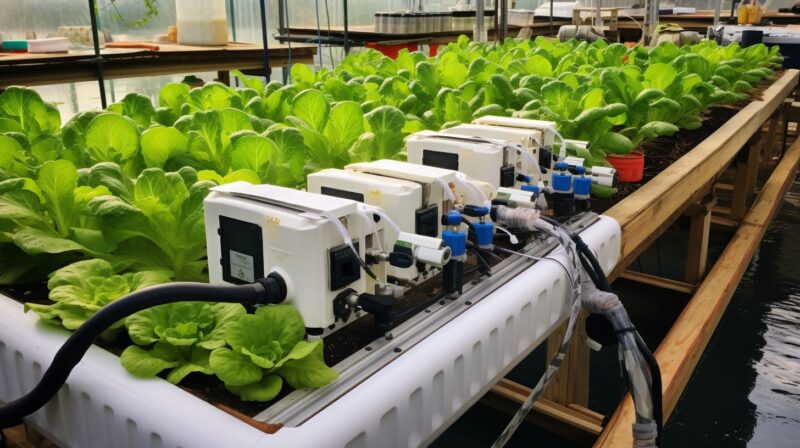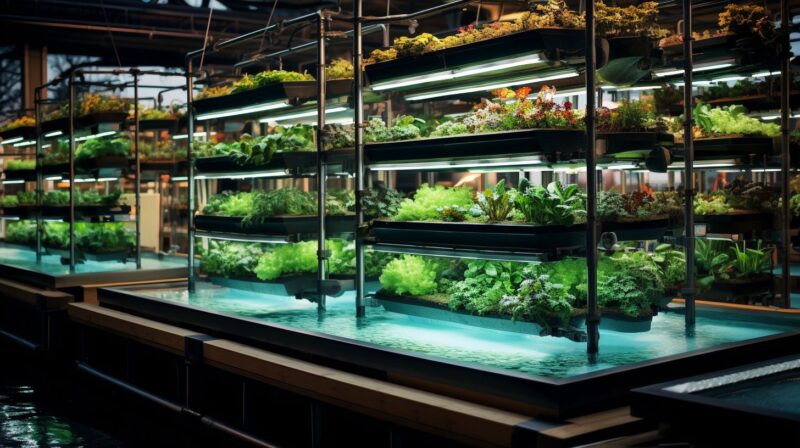This post may contain affiliate links and we may earn a small commission when you click on the links at no additional cost to you. As an Amazon Affiliate, we earn from qualifying purchases. You can read our full disclaimer here.
If you’re considering setting up an aquaponics system, you’ll quickly realize that pumps and timers for aquaponics are critical components for its success. Pumps are responsible for circulating the water and oxygenating it, while timers regulate the feeding, lighting, and water flow in your system.
Without pumps and timers, your aquaponics setup would not function efficiently, and your plants and aquatic animals would not receive the necessary nutrients and oxygen to thrive.
In this article, we will guide you through the importance of pumps and timers in aquaponics systems, the different types available, how to choose the right one for your setup, and how to integrate them into your system. We’ll also provide troubleshooting tips, industry recommendations, and cost considerations to help you maximize efficiency and yield in your aquaponics system.
Key Takeaways:
- Pumps and timers are essential components for aquaponics systems.
- Pumps circulate water and oxygenate it, while timers regulate feeding, lighting, and water flow.
- The right selection and use of pumps and timers can significantly improve the efficiency and yield of your system.
- We will guide you through the process of choosing and integrating pumps and timers into your setup, provide troubleshooting tips, and industry recommendations to help you maximize efficiency and yield.
Understanding the Role of Water Pumps in Aquaponics
Water pumps play a critical role in maintaining proper water circulation and oxygen levels within your aquaponics system. If the pump is not dependable, it will prevent water from flowing from the fish tank to the grow bed, and the plants will not receive the nutrients they need. A high-quality water pump is essential for the success of your aquaponics system.

There are two types of water pumps commonly used in aquaponics: submersible and external. Submersible pumps are placed directly in the fish tank or sump, while external pumps are installed outside of the tank and are connected to the system via piping.
| Pump Type | Advantages | Disadvantages |
|---|---|---|
| Submersible | Easy to install, quiet operation, suitable for small systems | Prone to clogging, harder to access for maintenance, limited flow rate |
| External | Higher flow rates, easier to maintain, less prone to clogging | Louder operation, requires more planning for setup, may be more expensive |
When choosing a water pump for your aquaponics system, consider factors such as flow rate, head height, and energy efficiency. This will be further discussed in the following section.
To ensure optimal performance, it’s recommended to use a pump specifically designed for aquaponics. The best pumps for aquaponics are those that can handle the unique demands of the system, such as continuous operation and the handling of solids. Research and choose a pump that fits your system requirements and budget.
Choosing the Right Water Pump for Your Aquaponics System
When selecting a water pump for your aquaponics system, there are several factors you should consider to ensure optimal performance and efficiency.
| Factor | Description |
|---|---|
| Flow rate | The flow rate determines how quickly it can move water throughout the system. The flow rate necessary for your aquaponics system depends on your setup’s size and the plants and fish you are raising. |
| Head height | The head height is the vertical distance between the water pump and the highest point of the aquaponics setup. A pump with a lower head height may not be able to reach all areas of the system, causing inadequate water flow and poor oxygenation. |
| Energy efficiency | Energy-efficient water pumps can save you money on your electricity bill and reduce carbon footprint. Pumps with a high energy efficiency rating ensure that you are getting the most out of your system while minimizing your environmental impact. |
It’s important to also take into account the noise that the pump produces, as certain models can be very loud and cause disruptions.
Ultimately, selecting the right water pump for your aquaponics system will depend on the specific needs of your setup. Prior to making any decision, it is crucial to conduct extensive research and seek advice from experts in the relevant field. By doing so, you can ensure that your choice is an informed one.

Types of Timers for Aquaponics Systems
When it comes to selecting a timer for your aquaponics system, you have several options to choose from. It is important to weigh the pros and cons of each timer type and take into account your personal requirements and preferences before selecting one. Here are some of the most common types of timers for aquaponics:
Digital Timers
Digital timers are a popular choice for aquaponics systems because they offer precise control over water flow, lighting, and feeding schedules. They typically come with a built-in clock and programming options that allow you to set specific on and off times for various system components. Digital timers are also easy to use and often come with a user-friendly interface.
Analog Timers
Analog timers are another common type of timer for aquaponics systems. They use a mechanical dial to set on and off times for system components, and they are typically more affordable than digital timers. However, analog timers may be less accurate than digital timers and require more manual adjustments to maintain proper timing.
Programmable Timers
Programmable timers are a hybrid between digital and analog timers. They offer the precision and programming options of digital timers while also incorporating mechanical dials for manual adjustments. This type of timer is a good choice for those who prefer the flexibility of analog timers but also want the accuracy and convenience of digital timers.
When selecting a timer for your aquaponics system, it’s important to consider factors like ease of use, accuracy, and compatibility with other components in your setup. By understanding the different types of timers available and their unique features, you can make an informed decision that meets your specific needs.
Factors to Consider When Choosing Timers for Aquaponics
Choosing the right timer for your aquaponics system is crucial to its functionality and efficiency. Here are some key factors to consider when selecting a timer:
- Automatic vs. Manual: Do you want a timer auto-regulates the flow of water, lighting, and feeding, or one that you need to manually adjust?
- Number of outlets: Consider the number of devices you need to control, such as pumps, lights, and feeders, and choose a timer that can accommodate them all.
- Scheduling options: Look for a timer that offers multiple scheduling options, such as daily and weekly, to maximize flexibility and control over your system.
- Compatibility: Make sure the timer you choose is compatible with other system components, such as pumps and lights.
- Ease of use: Select a timer that is effortless to set up and operate, equipped with straightforward guidelines and user-friendly controls.
- Reliability: When searching for a timer, it is important to find one that is dependable and long-lasting, with a proven track record of performance and reliability.
- Energy efficiency: Consider a timer that is energy-efficient and can help reduce overall system energy consumption and costs.
By considering these factors when selecting a timer for your aquaponics system, you can ensure optimal performance and efficiency, while reducing manual labor and maintenance costs.
Integrating Pumps and Timers in Your Aquaponics System
Now that you have chosen the best pumps and timers for your aquaponics system, it’s time to integrate them for optimal performance. Here are some steps to help you with the installation process:
- Begin by identifying the best location for your water pump. It should be close to the fish tank and at the lowest point of the water system to ensure proper water flow.
- Connect the water pump with the tubing that runs to the grow bed. Make sure that the tubing is secured properly to prevent any leaks.
- If you’re using an automatic timer, connect it to the pump and follow the instructions provided in the manual to set it up. You can customize the timer settings according to the needs of your system.
- If you’re using a separate timer for your lighting and feeding schedules, connect them accordingly to ensure that they work in harmony with the water pump timer.
- Maintaining your pumps and timers regularly is crucial for optimal efficiency. Check for any clogs or blockages in the tubing and replace any broken parts immediately.

By integrating your pumps and timers correctly, you can ensure that your aquaponics system runs efficiently and produces the best possible yield. With a little bit of effort, you can reap the benefits of a thriving aquaponics setup that not only benefits your plants, but also the environment.
Troubleshooting Common Issues with Pumps and Timers
Pumps and timers are crucial components of your aquaponics system. However, they can sometimes experience issues that may disrupt their functionality. In this section, we will provide you with tips to troubleshoot common issues with pumps and timers.
Clogging
Clogging is a common issue with water pumps in aquaponics systems. It occurs when debris, fish waste, or clog pumps, which reduces water flow and affects system efficiency. To fix this issue, you can take the following steps:
- Clean the pump’s intake to remove any debris or waste that may have accumulated.
- Install a pre-filter to prevent debris and waste from entering the pump.
- Check the pipes and tubing for clogs and clean them if necessary.
Inadequate Water Flow
Inadequate water flow can lead to poor oxygenation and nutrient distribution, affecting plant growth and fish health. The following steps solve this issue:
- Check the pump’s flow rate and ensure it’s suitable for the size of your aquaponics system.
- Increase the pump’s head height to improve water flow.
- Check the pipes and tubing for damage or leaks and replace them if necessary.
Timer Malfunctions
Timer malfunctions can cause disruptions to your aquaponics system’s feeding and lighting schedules. What you can do is to:
- Check the timer’s settings to see if they’re correctly configured.
- Reset the timer to its factory settings and reprogram it.
- Replace the timer’s battery if it’s low or dead.
- Check the timer’s wiring for damage or loose connections.
If the above solutions do not solve your pump or timer issue, consult a professional or the manufacturer for further assistance.
Maximizing Efficiency and Yield in Your Aquaponics System
If you want to get the most out of your aquaponics system, it’s essential to pay close attention to your pumps and timers. By making the right choices and optimizing their use, you can significantly improve the efficiency and yield of your system.
Optimizing Water Flow
One of the most crucial factors in maximizing efficiency is optimizing water flow. If water isn’t flowing correctly throughout the system, plants may not receive the nutrients they need, and the fish may not have enough oxygen.
To optimize water flow, ensure that your pump is properly sized for the system, and that it’s positioned in a way that allows water to circulate effectively. You should also regularly clean your pump and remove any debris that may be blocking the flow of water.
Distributing Nutrients
Proper nutrient distribution is another critical factor in maximizing yield. Ensuring the equal distribution of nutrients throughout the system is crucial for enabling plants to access the vital nutrients required for their growth and overall well-being.
To achieve this, you may need to adjust the flow rate of your pump or consider adding additional pumps or air stones to increase circulation and oxygenation. Regularly testing the nutrient levels in your system can also help you ensure proper distribution.
Regular Maintenance
Maintaining your pumps and timers is essential to keep your system running smoothly and efficiently. Regularly cleaning and inspecting your equipment can prevent clogs and malfunctions that can hinder performance.
You’ll also want to make sure your timers are working correctly, and that feeding and lighting schedules are optimized for maximum efficiency and yield.
By following these tips and making the right choices when it comes to pumps and timers, you can maximize the efficiency and yield of your aquaponics system and enjoy a bountiful harvest.
Cost Considerations and Return on Investment
Investing in quality pumps and timers for your aquaponics system may seem expensive upfront, but it can have long-term benefits that outweigh the cost. The price of a pump and timer system may vary based on the size of your setup and the specific functionalities you need.
Consider the return on investment (ROI) that a well-designed and efficient aquaponics system can provide. Using the best pumps and timers can increase productivity, reduce maintenance costs, and improve the overall yield of your system.

Investing in pumps that have energy-efficient motors can result in substantial savings on electricity bills. Similarly, using programmable timers can reduce the need for manual labor and increase precision in controlling water circulation and feeding schedules.
When selecting pumps and timers for your aquaponics system, it’s important to balance cost considerations with long-term benefits. Remember that quality equipment can lead to better efficiency, productivity, and yield, ultimately resulting in a higher ROI for your aquaponics setup.
Industry Recommendations for Pumps and Timers in Aquaponics
Choosing the ideal pumps and timers for your aquaponics setup may seem daunting due to the vast variety of options on the market. To help you make an informed decision, we have compiled a list of industry recommendations from experts in the field.
| Brand | Model | Features |
|---|---|---|
| Hydrofarm | Active Aqua Submersible Water Pump | Energy-efficient, quiet operation, multiple sizes available |
| EcoPlus | Eco 396 Submersible Water Pump | High flow rate, durable design, low energy consumption |
| Titan Controls | Apollo 9 Digital Timer | Easy-to-use, programmable, 24-hour cycle |
| Century | 7-Day Programmable Digital Timer | Up to 8 on/off settings per day, battery backup, affordable price |
These are just a few examples of quality pumps and timers that have received recognition and positive feedback from aquaponics experts. Please remember that the suitable pump and timer for your system will vary based on your particular requirements and personal preferences.
It is advisable to invest time in researching and comparing various brands and models to identify the most suitable option for your aquaponics system. Don’t hesitate to consult with experts and seek advice from fellow aquaponics enthusiasts to ensure you make an informed decision.
Below are some of our recommended water pumps for your system:
Current USA eFlux DC Flow Pump with Flow Control
Features:
- Adjustable Flow: The eFlux DC Flow Pump is powered by a DC motor, allowing for precise flow control. The flow rate can be adjusted using a dial to achieve the desired water movement in your aquarium.
- Submersible or External Installation: This pump is versatile and can be installed either submerged within the water or externally in-line with your plumbing system. Quick-couple hose barb fittings are included for easy installation.
- Compact Design: The eFlux Flow Pump has a small footprint, making it suitable for various setups, including tight spaces and smaller sumps.
- Energy Efficiency: The pump operates with a sealed DC motor and magnetic drive design, resulting in efficient water flow with high pressure. It is designed to be energy-saving, consuming 65% less energy compared to traditional AC pumps.
- Suitable for Saltwater and Freshwater: The pump is safe for use in both saltwater and freshwater aquarium systems.
- Loop Compatible: The pump can be integrated into the LOOP system, allowing for centralized control of lights, pumps, and other accessories.
- Soft Start and IC Electronic Detection: The pump features a soft start function that gradually ramps up the speed to prevent sudden surges. It also includes IC electronic detection to protect the pump when no water is present.
FREESEA 1100 GPH 100W Submersible Water Pump
Features:
- Smart Control for Dry Running Protection: The pump has a smart control feature that automatically cuts off power in case of dry running. This prevents the motor from overheating and damaging itself. The motor restarts once the temperature returns to normal.
- Submersible Design: The pump is 100% submersible, meaning it can operate underwater without any issues. This makes it suitable for use in ponds, aquariums, waterfalls, and hydroponic systems.
- High Flow Rate and Lift Height: The pump boasts a maximum flow rate of 1100 gallons per hour (GPH) with a strong lifting capability. It can lift water to a maximum height of 11 feet, making it suitable for various water circulation and filtration applications.
- Energy-Efficient Motor: The pump is equipped with a high-efficiency 100W motor, which not only provides strong pumping power but also contributes to energy savings.
- Easy Installation with Suction Cup and Long Power Cord: The pump comes with a suction cup for secure attachment to surfaces and a 5.9-ft power cord, allowing for flexible and convenient installation. The suction cup ensures stability, and the long power cord makes setup easier.
hygger 800GPH Quiet Submersible and External 24V Water Pump
Features:
- Adjustable Flow Speed: The water pump comes with an external LED display controller that offers 71 flow speed settings, allowing you to control the flow rate from 30% to 100% of the top speed flow. The controller includes “Up,” “Down,” and “Pause” buttons for easy adjustment.
- Internal & External Use: The hygger water pump can be used either externally or submerged in water. While the pump itself is suitable for underwater use, the controller is not waterproof and needs to be placed indoors. The package includes screws, O-rings, and pipe connection fittings for installation.
- Durable Construction: The pump is designed with a wear-resistant ceramic shaft and a magnetic drive, ensuring a long service life. It is suitable for both fresh water and salt water applications. The absence of copper elements contributes to its versatility.
- Auto Shut Off When No Water: The pump features an auto shut-off function to prevent damage. When there is no water detected or the water level is too low, the pump will automatically turn off. The package includes two types of removable water intake screens—one for normal water levels and the other for low water levels (above 0.8 inches).
- Specifications: The pump operates quietly and efficiently, providing powerful water return. It operates at an input voltage of 100-240V, 50/60Hz, and an output voltage of DC 24V. The pump’s dimensions are 6.2 x 3.1 x 5 inches, and it comes with a 6.2-foot cord length from the pump to the controller. The pump’s wattage, flow rate, and head height are indicated in the provided chart for different models.
Below are some of the recommended digital, analog, and programmable timers:
Orbit 24632 B-hyve XD 2 Port Sprinkler
Features
- Hyper-Local Precision: When paired with the Wi-Fi Hub (sold separately), the XD 2 Port Sprinkler controls watering based on your property attributes and real-time local weather data, ensuring precise irrigation.
- Hybrid Device Control: The XD sprinkler timer can be programmed directly on the device, locally via Bluetooth, or remotely through Wi-Fi. This offers flexibility in managing your watering schedule according to your convenience.
- Weatherproof Design: The XD sprinkler timer is IP60 Certified, making it weatherproof and capable of withstanding extreme outdoor conditions. This durability ensures it can be used in your yard or garden throughout the summer.
- Drought-Tolerant and Customizable: The XD timer understands the drought levels in your area and adjusts watering automatically. Additionally, you can customize drought settings to fine-tune the irrigation process. It also facilitates easy implementation of local watering restrictions.
- EPA Certified and Environmentally Friendly: All B-hyve timers and controllers, including the XD 2 Port Sprinkler, are WeatherSense-certified by the Environmental Protection Agency (EPA). This certification emphasizes the product’s environmentally conscious design and efficient water usage.
Orbit 62034 Mechanical Watering Hose Timer
Features:
- Easiest Timer to Use: The timer is designed to be user-friendly, working similar to an egg timer. It allows you to set the desired watering time, ranging from 15 to 120 minutes.
- Water Conservation: This timer helps in conserving water by ensuring that you never forget to turn off the water. It has an automatic shut-off feature that stops the water flow once the set time is reached.
- Oversized Dial: The timer features an oversized dial with a comfortable grip. This makes it easy to set the timer, even when you have wet or gloved hands.
- Durable Construction: The timer is built with quality materials to ensure durability throughout the seasons. It’s designed to resist rust and corrosion, making it suitable for outdoor use.
- Easy Attachment and Manual Water Override: The timer has an ergonomic swivel attachment that can be quickly and easily connected to your faucet. It also features a manual water override option, allowing you to access water without removing the timer. Additionally, no batteries are required for its operation.
Orbit 58910 Programmable Hose Faucet Timer
Features:
- Programmable Valves: The timer features 2 programmable valves that provide flexible control over watering duration and frequency.
- Water Conservation: The timer includes rain delay and manual watering functions, ensuring maximum water conservation by preventing unnecessary watering.
- Battery Powered: The timer operates on two alkaline batteries (sold separately) and can handle up to 4000 on and off cycles, providing efficient and reliable performance.
- Durable Construction: Made from durable plastic material, the timer is designed to withstand outdoor conditions. It comes with a 6-year limited manufacturer warranty for peace of mind.
- Multiple Outlet Options: The timer is available in different outlet configurations, including 2 outlets, allowing you to control multiple watering zones with a single device.
Conclusion
By now, you should have a good understanding of how pumps and timers are essential components of any aquaponics system. You learned about the role of water pumps in maintaining proper circulation and oxygenation, and the benefits of automatic timers in regulating feeding and lighting schedules.
Choosing the right pumps and timers for your specific setup is crucial to ensure maximum efficiency and productivity. Consider factors like flow rate, head height, energy efficiency, and compatibility with other system components when making your selection.
Integrating pumps and timers into your aquaponics system is a straightforward process, and with proper installation and maintenance, you can avoid common issues like clogging and inadequate water flow.
Investing in quality pumps and timers may come at a higher cost, but the potential return on investment through increased productivity and reduced maintenance expenses is well worth it. Industry recommendations can guide you towards reliable and efficient brands and models.
Take Action Today
Now that you have gained a thorough understanding of pumps and timers in aquaponics systems, it’s time to apply your knowledge in practice. Start by assessing your current setup and identifying areas where pumps and timers could increase efficiency and productivity. Then, research and select the best pumps and timers for your specific needs, and integrate them into your system. With the right components and proper maintenance, you can take your aquaponics setup to the next level.



